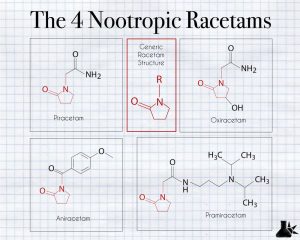Racetams are synthetic nootropics with closely related structures and effects. They improve brain health, help with learning, boost memory, and promote anti-anxiety support and good mood. Here is a comparison of the most common racetams and their applications.
Piracetam
This is good for beginners because it is mild and does not come with any serious side effects. It was initially used and is still meant for addressing the cognitive decline in elderly patients. Piracetam boosts cellular membrane fluidity. The nootropic is ideal for providing a slight edge in memory retention and learning. Additionally, it helps boost your sensory concentration and focus.
The recommended dose for piracetam is 1,2000-4,800 mg daily. However, some people get impressive results with doses of up to 10,000mg.
Aniracetam
Aniracetam has a well-documented mechanism of action. The nootropic targets your brain’s AMPA receptors and interacts with dopamine, choline, and serotonin. These are neurotransmitters involved with analyzing your mental well-being. This is the reason aniracetam has a soothing effect on stress and anxiety. Additionally, the nootropic is known to boost productivity in your right brain hemisphere, the region that focuses on creative thinking. Aniracetam is thus suited for holistic thinking, creativity, and reducing anxiety and stress.
The recommended dose of aniracetam is 400-1,500 mg every day, split to 2-3 servings. Due to its potent effect, some people experience high-level relaxation when on aniracetam and become less motivated to engage in any mental work. The other side effects include insomnia, headaches, vertigo, and nausea.
Oxiracetam
Oxiracetam has a different structure from piracetam. It consists of an additional single hydroxyl group. Apart from offering the same benefits provided by piracetam, it also increases glutamate, D-aspartic acid, and acetylcholine release from neurons. When these substances are released, you experience more metabolic activity in the brain’s neurons and this helps improve memory formation. In addition to memory improvement, studies have shown that oxiracetam offers the best promise against neural decline and helps improve attention, memory, and logical thinking. This is the ideal nootropic for a student who wants to boost their mental faculties when studying.

The recommended dosage of oxiracetam is 1,200-2,400 mg split into 2-3 doses daily, preferably one hour before any learning activity. The main side effects of oxiracetam include restlessness, nausea, brain fog, and mild headaches.
To wrap up, piracetam is best suited for cognitive enhancement whereas oxiracetam helps enhance logical thinking. On the other hand, aniracetam is a cognitive and memory booster. Piracetam helps in memory retention and learning but is far weaker than oxiracetam and aniracetam. Oxiracetam is stronger than both aniracetam and piracetam. Aniracetam is up to 5 times more potent than piracetam. While the main benefits of piracetam are concentration and focus, oxiracetam is a stimulant while aniracetam is mainly associated with improving mood and promoting creative thinking. However, piracetam is better than oxiracetam for the treatment of agitation and anxiety. On the flip side, oxiracetam is far much potent than piracetam in improving memory. Aniracetam has been found to increases activity in the right brain hemisphere which is concerned with creativity. Both aniracetam and oxiracetam boost long-term potentiation in your hippocampus.